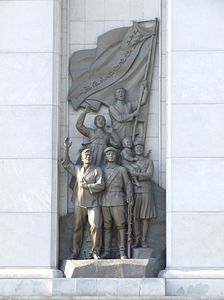Arch of Triumph (Pyongyang)
Kim Il-sung 's resistance to Japan |
| Arch of Triumph | |
| Chosŏn'gŭl | 개선문 |
|---|---|
| Hancha | |
| Revised Romanization | Gaeseonmun |
| McCune–Reischauer | Kaesŏnmun |
The Arch of Triumph (
Korean resistance to Japan from 1925 to 1945. It is the second tallest memorial arch in the world, after Monumento a la Revolución in Mexico, standing 60 m (197 ft) high and 50 m (164 ft) wide.[1]
Built in 1982 on the Triumph Return Square at the foot of
Kim Il-sung's role in the military resistance for Korean independence. Inaugurated on the occasion of his 70th birthday, each of its 25,500 blocks of finely-dressed white granite represents a day of his life up to that point.[2]
Design
The structure is modeled after the
Song of General Kim Il-sung", and the year 1925, when North Korean history states that Kim set out on the journey for national liberation of the country from Japanese rule.[3]
Also depicted on the arch is the year 1945, when Korea was liberated.
The arch is illuminated at night and has its own single cylinder diesel generator in case of main power failure.
Gallery
See also
- Korean architecture
- Tourism in North Korea
- Juche Tower
- Kaeson Revolutionary Site
- Monument to Party Founding
Notes
- ^ "Guide to Pyongyang". The People's Korea. Archived from the original on 2008-09-27. Retrieved 2009-01-25.
- ISBN 1-56025-557-9.
- ISBN 978-0-85728-234-7.
References
- Korean Central News Agency of DPRK. link – last accessed on January 19, 2006.
External links
Wikimedia Commons has media related to Arch of Triumph (Pyongyang).




